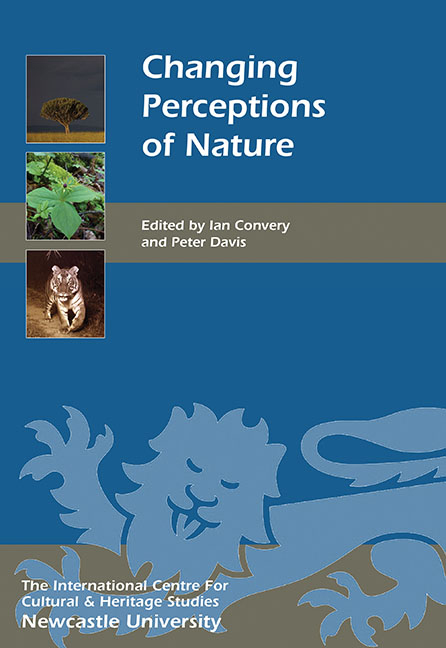Book contents
- Frontmatter
- Contents
- List of Illustrations
- Acknowledgments
- List of Abbreviations
- Foreword
- Introduction
- HISTORICAL PERSPECTIVES ON NATURE
- COLLECTING NATURE
- INTERPRETING NATURE AND LANDSCAPES
- CONSERVING NATURE
- PEOPLE–NATURE INTERACTIONS
- 22 Adventure, Nature and Commodification
- 23 Destination Nature: Wildlife and the Rise of Domestic Ecotourism in Britain, 1880–2015
- 24 Wild Places as Therapeutic Environments
- 25 Citizen Science and the Perception of Nature
- 26 Using Community-based Cultural Tourism to Enhance Nature Conservation in the Rupununi, Guyana
- 27 Representing Natural Heritage in Digital Space: from the National Museum of Natural History to Inuvialuit Living History
- 28 Out of the Wild Wood and into our Beds: the Evolutionary History of Teddy Bears and the Natural Selection of Deadly Cuteness
- 29 Rewilding: the Realisation and Reality of a New Challenge for Nature in the Twenty-first Century
- List of Contributors
- Index
- Miscellaneous Endmatter
23 - Destination Nature: Wildlife and the Rise of Domestic Ecotourism in Britain, 1880–2015
from PEOPLE–NATURE INTERACTIONS
Published online by Cambridge University Press: 26 October 2017
- Frontmatter
- Contents
- List of Illustrations
- Acknowledgments
- List of Abbreviations
- Foreword
- Introduction
- HISTORICAL PERSPECTIVES ON NATURE
- COLLECTING NATURE
- INTERPRETING NATURE AND LANDSCAPES
- CONSERVING NATURE
- PEOPLE–NATURE INTERACTIONS
- 22 Adventure, Nature and Commodification
- 23 Destination Nature: Wildlife and the Rise of Domestic Ecotourism in Britain, 1880–2015
- 24 Wild Places as Therapeutic Environments
- 25 Citizen Science and the Perception of Nature
- 26 Using Community-based Cultural Tourism to Enhance Nature Conservation in the Rupununi, Guyana
- 27 Representing Natural Heritage in Digital Space: from the National Museum of Natural History to Inuvialuit Living History
- 28 Out of the Wild Wood and into our Beds: the Evolutionary History of Teddy Bears and the Natural Selection of Deadly Cuteness
- 29 Rewilding: the Realisation and Reality of a New Challenge for Nature in the Twenty-first Century
- List of Contributors
- Index
- Miscellaneous Endmatter
Summary
There is a blithe acceptance in Britain that ecotourism is purely a contemporary phenomenon, born from the international sustainable tourism industry and development debates of the 1980s (riding on the back of the rise of environmentalism in the Western world in the 1960s and 1970s); it is also perceived that ecotourism primarily takes place ‘overseas’ (Page and Dowling 2002; Diamantis 2004; Fennell 2008). This chapter maps out stepping stones in the rise of a ‘domestic’ ecotourism industry in Britain from the late ninteenth and across the twentieth century, when people began to consciously take ‘delight’ in nature (Thomas 1984; Smout 2000; Holden 2008). Every year around 300,000 people visit sites in Britain to see ospreys, pumping £3.5m into local economies, often in remote rural areas (McCraight 2005). Much of this rise in mass wildlife watching has been founded not just on physical infrastructure developments and conservation policy initiatives, but on enormous shifts in human attitudes and values. These changes have meant that many bird species, in particular birds of prey (Cairns and Hamblin 2007; Cobham 2014), previously persecuted as ‘vermin’ in predator control endeavours (Lovegrove 2007) and ultimately protected, are now regarded as valuable sustainable ecotourism icons. This change in attitudes has taken less than a century (Lambert 2011).
THE GATHERING OF THE TRIBE
The British Birdwatching Fair takes place every August at Rutland Water Nature Reserve, in England's smallest county. Known as ‘the birder's Glastonbury’, it regularly attracts over 22,000 visitors; in 2014, the ten marquees were filled with 370 exhibitors from 58 countries, around 160 (43%) of whom were listed in the programme as ‘travel and tourism’ operators. The roots of this festival for birds (although now, with increased public interest and connections with other taxa, it should surely be renamed the ‘British Wildlife Fair’) date back to a meeting between warden Tim Appleton (Leicestershire and Rutland Wildlife Trust) and Martin Davies (Royal Society for the Protection of Birds) in the late 1980s, after a successful local event called ‘The Wildfowl Bonanza’ was held at Rutland Water in 1987.
- Type
- Chapter
- Information
- Changing Perceptions of Nature , pp. 235 - 244Publisher: Boydell & BrewerPrint publication year: 2016

